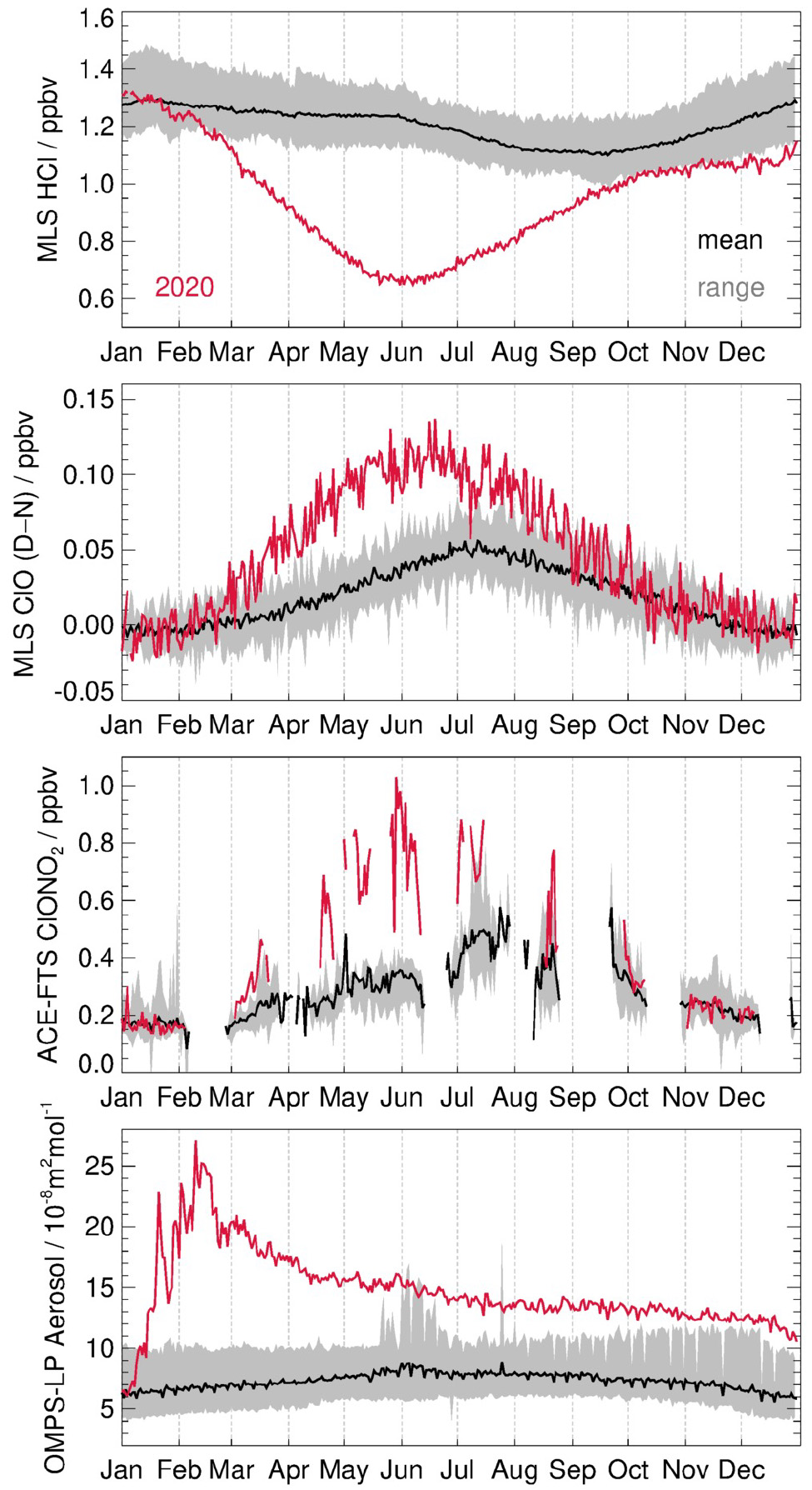Measurements from the Aura Microwave Limb Sounder (MLS) and other satellite sensors revealed unprecedented prolonged and pervasive perturbations in the composition of the Southern Hemisphere (SH) midlatitude LS in the wake of ANY. In particular, a steep increase in aerosols (exceeding climatological mean values by a factor of ~4) was followed by a deep depletion in HCl, the main stratospheric chlorine reservoir species, as well as strong enhancements in ClO, the main form of ozone-destroying reactive chlorine, and ClONO2, another chlorine reservoir.
Maximum anomalies in HCl (50%–60% below average) and the other chlorine species were observed in mid-2020, months after ANY. Analysis of other trace gases from MLS provides convincing evidence that these anomalies primarily arose from chemical, not transport, effects. Heterogeneous reactions that convert chlorine from reservoir to reactive forms are known to occur in the midlatitude LS on the surfaces of particles such as cirrus clouds or volcanic or background sulfate aerosols. However, these reaction rates are typically negligible under the meteorological conditions prevailing in the SH midlatitude LS at the time of the anomalous chlorine repartitioning in 2020.
We conclude that abundant and widespread smoke particles from ANY provided ample surfaces on which efficient chlorine activation could take place over a large fraction of the hemisphere for several months. Although such sustained midlatitude enhancement in reactive chlorine is unmatched in the record, it was still far weaker than that in the Antarctic ozone hole, inducing at most minor changes in SH midlatitude LS ozone.

Time series of trace gases and aerosols averaged over 38S–54S equivalent latitude at 480 K (~19.5 km): 2020 vs. climatology and range of values over 2005–2019.
Technical Description of Figure(s):
Adapted from Figure 3 of above reference. Time series of averages over the 38S–54S band of equivalent latitude (EqL) at 480-K potential temperature (~19.5 km in this EqL band in June) of (top to bottom) Aura Microwave Limb Sounder (MLS) HCl, MLS ClO, Atmospheric Chemistry Experiment–Fourier Transform Spectrometer (ACE-FTS) ClONO2, and Ozone Mapping and Profiler Suite Limb Profiler (OMPS-LP) aerosol (converted to cross section per mole of air (m2 mol-1)). 2020 data shown in red. Grey shading depicts the envelope of behavior and black lines the mean over the period 2005–2019 for MLS and ACE-FTS and 2013–2020 for OMPS-LP.
Scientific significance, societal relevance, and relationships to future missions:
In late December 2019/early January 2020, during the devastating Black Summer fire season in Australia, an intense outbreak of a number of fire-induced and smoke-infused thunderstorms (termed pyrocumulonimbus, pyroCbs) occurred, collectively known as the Australian New Year’s (ANY) event. MLS and ACE–FTS provide unique measurements of the primary components of the stratospheric chlorine budget, along with transport tracers.
In the months following ANY, well after distinct plumes of fire-influenced air dispersed, these data show unprecedented prolonged and pervasive depletion in HCl (50%–60% below climatology) and enhancements in both ClO and ClONO2 in the SH midlatitude lower stratosphere that were not transport related, with peak anomalies occurring in mid-2020.
We conclude that the observed perturbations likely arose from heterogeneous chlorine activation on widespread aged smoke particles. Although such sustained enhancement in reactive chlorine had never before been observed in the midlatitudes, it was still an order of magnitude or more weaker than that in a typical stratospheric winter polar vortex and induced at most minor changes in ozone. Detailed investigation, including chemical modeling, will be needed to identify the specific characteristics of the ANY smoke particles that facilitated such dramatic midlatitude chlorine repartitioning.
Deeper understanding of the processes involved is critical to assessing the likelihood of significant changes in midlatitude composition in a future climate in which the stratosphere is expected to be colder, wetter, and more frequently affected by pyroCb events. No confirmed plans for future spaceborne measurements of stratospheric HCl, ClO, or ClONO2 (by NASA or other agencies) currently exist.
Data Sources:
Aura MLS Level 2 data; Aura MLS Derived Meteorological Products (DMPs): (registration required); ACE-FTS 4.1 (registration required)); OMPS-LP L2 Aerosol Extinction Vertical Profile swath multi-wavelength daily 3slit Collection 2 V2.0 data: (Taha, 2020) ; MERRA-2:
References:
Santee, M.L., A. Lambert, G.L. Manney, N.J. Livesey, L. Froidevaux, J.L. Neu, M.J. Schwartz, L.F. Millán, F. Werner, W.G. Read, M. Park, R.A. Fuller, and B.M. Ward. (2022). Prolonged and Pervasive Perturbations in the Composition of the Southern Hemisphere Midlatitude Lower Stratosphere From the Australian New Year’s Fires, Geophys. Res. Lett., 49, e2021GL096270. https://doi.org/10.1029/2021GL096270.
03.2022